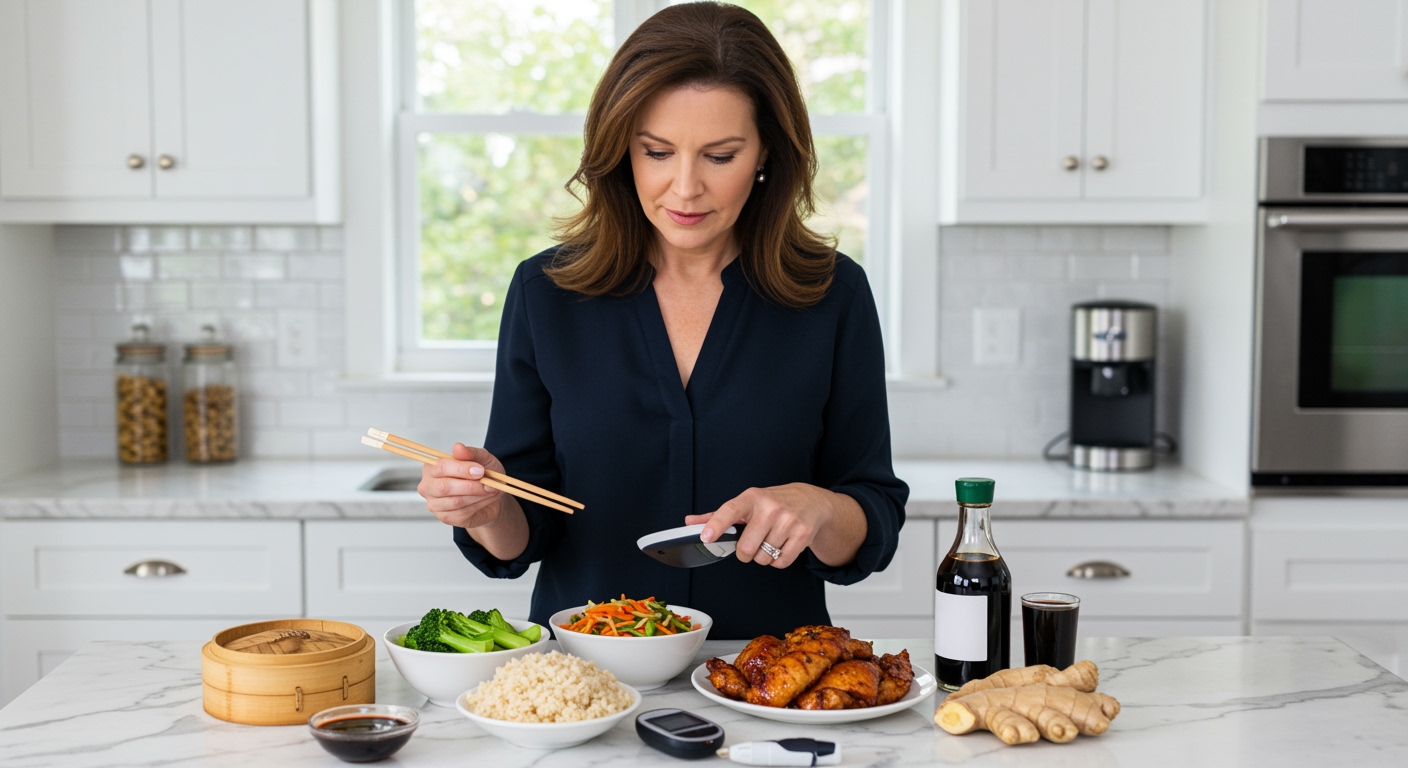✪ Key Takeaway: Chinese food can be diabetes-friendly when you choose steamed dishes, avoid sweet sauces, and control portions carefully.
Introduction
Your favorite Chinese restaurant just called your name, but your blood sugar monitor is staring back at you with judgment.
You might be wondering if Chinese food will send your glucose levels through the roof or if there are safe options hiding behind those tempting menu descriptions.
Hi, I’m Abdur, your nutrition coach and today I’m going to explain exactly how Chinese food affects your blood sugar and which dishes you can enjoy without worry.
What Makes Chinese Food Risky For Blood Sugar?
Traditional Chinese restaurant food often contains hidden sugars that can spike your blood glucose faster than you expect.
Sweet and sour sauce contains up to 15 grams of sugar per serving, while teriyaki and orange chicken sauces pack similar amounts of refined carbohydrates.
Deep-fried dishes like General Tso’s chicken combine high-glycemic flour coating with sugary sauces, creating a double impact on your blood sugar levels.
White rice serves as the foundation for most Chinese meals, but one cup contains 45 grams of fast-absorbing carbohydrates that convert to glucose within 30 minutes of eating.
Cornstarch thickeners in many sauces add extra carbohydrates without obvious sweetness, making it difficult to estimate the total glycemic load of your meal.
✪ Fact: A typical orange chicken dinner contains 80-90 grams of carbohydrates, equivalent to eating 6 slices of white bread.
Which Chinese Dishes Are Actually Safe For Diabetics?
Steamed dishes represent your safest options because they avoid added sugars and excessive oils that complicate blood sugar management.
Steamed fish with ginger contains minimal carbohydrates while providing high-quality protein that helps stabilize glucose levels throughout your meal.
Buddha’s delight or mixed vegetable dishes offer fiber-rich options that slow down sugar absorption and provide essential micronutrients without spiking blood glucose.
Hot and sour soup contains vegetables and protein in a broth base with minimal added sugars, making it an excellent starter option that promotes satiety.
Moo goo gai pan features sliced chicken with mushrooms in a light sauce that typically contains fewer than 10 grams of carbohydrates per serving when prepared traditionally.
Beef and broccoli without rice provides protein and fiber while keeping total carbohydrates under 15 grams when you request sauce on the side.
✪ Pro Tip: Always ask for steamed brown rice instead of white rice to reduce the glycemic impact by 20-30%.
How Does Portion Size Affect Your Blood Sugar Response?
Chinese restaurants typically serve family-style portions that contain 2-3 times more food than your body needs for stable blood sugar control.
A standard serving of fried rice contains 2-3 cups, but your blood sugar stays more stable when you limit yourself to half a cup or less.
Sharing dishes allows you to taste multiple flavors while keeping your total carbohydrate intake within the 30-45 gram range that most diabetics can handle effectively.
Using smaller plates tricks your brain into feeling satisfied with less food, which helps prevent the post-meal spikes that damage blood vessels over time.
Taking home leftovers immediately after ordering prevents mindless overeating and gives you planned meals for the next day with controlled portions.
✪ Note: Your stomach takes 20 minutes to signal fullness, so eating slowly prevents accidental overconsumption.
What Should You Do Before And After Eating Chinese Food?
Testing your blood sugar before eating establishes your baseline level and helps you understand how different dishes affect your individual response.
Taking a 10-15 minute walk after your meal activates muscle glucose uptake and can reduce post-meal blood sugar spikes by 20-30%.
Drinking water throughout your meal helps with digestion and prevents dehydration that can worsen blood sugar fluctuations.
Planning your medication timing around restaurant meals ensures your insulin or other diabetes medications work optimally with your food intake.
Monitoring your blood sugar 2 hours after eating reveals which dishes work best for your body and helps you make better choices next time.
Keeping a food diary with blood sugar readings creates a personal database of safe Chinese dishes that you can order with confidence.
✪ Pro Tip: Eating a small protein snack 30 minutes before your meal can help prevent dramatic blood sugar swings.
The Bottom Line
Chinese food can absolutely fit into a diabetes-friendly eating plan when you make smart choices and control your portions carefully.
Your health depends on the choices you make today, not the convenience you choose tomorrow, and this applies perfectly to navigating Chinese restaurant menus with diabetes.
I would love to hear about your experiences with Chinese food and blood sugar management, so please share your questions or favorite diabetes-friendly dishes in the comments below.
References
At NutritionCrown, we use quality and credible sources to ensure our content is accurate and trustworthy. Below are the sources referenced in creating this article:
- PMC: Glycemic Index and Diabetes Management
- PMC: Dietary Patterns and Blood Sugar Control
- Frontiers in Nutrition: Cultural Foods and Diabetes Management
- NDSS: Glycaemic Index Guide Chinese Foods





